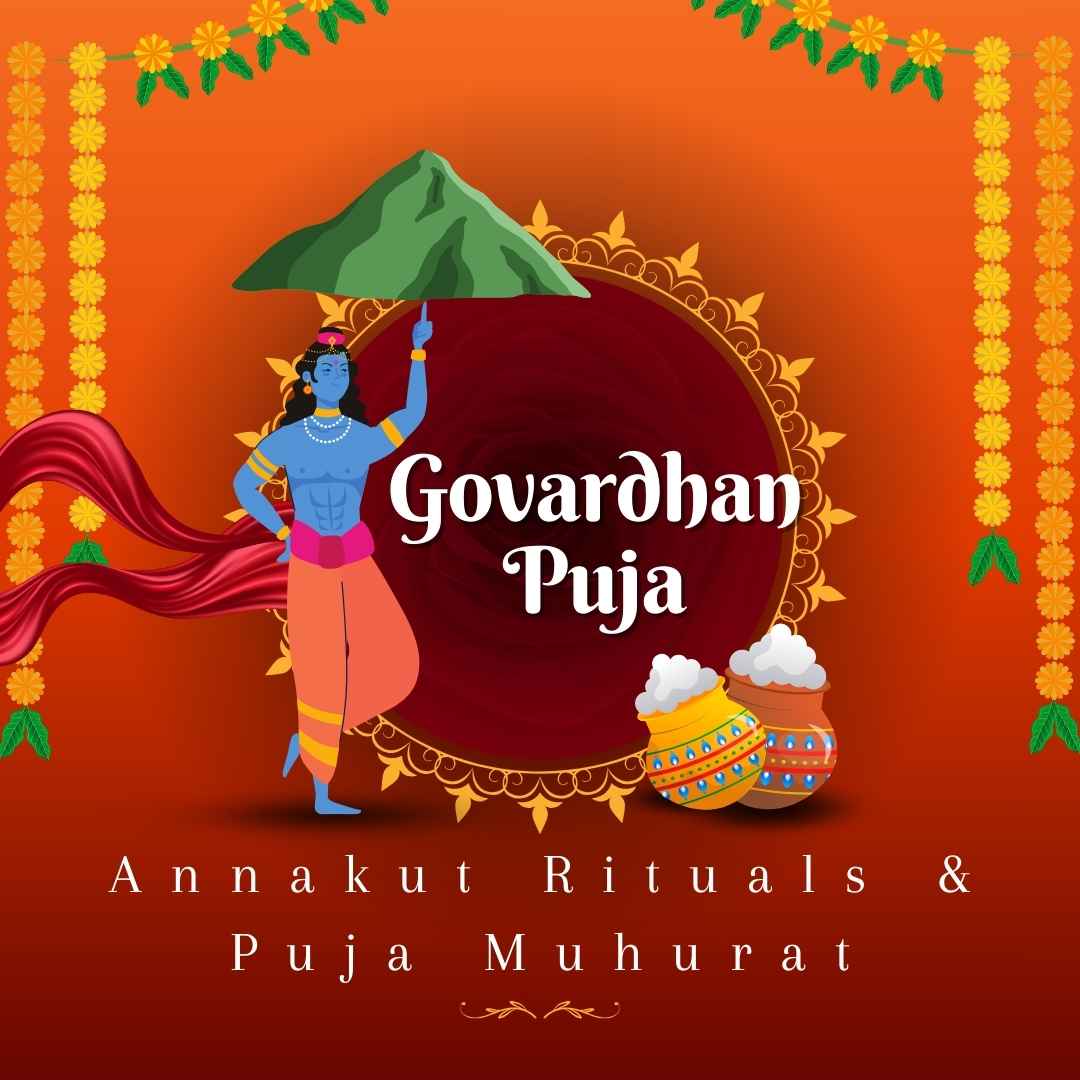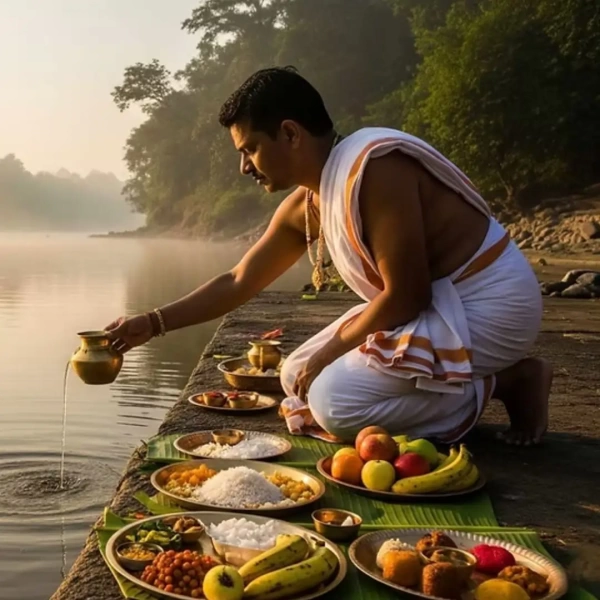Introduction to Govardhan Puja 2025
Govardhan Puja, also known as Annakut Puja, is a major Hindu festival celebrated on the first day (Pratipada) of the bright fortnight (Shukla Paksha) of the Kartik month, immediately following Diwali. The festival commemorates Lord Krishna’s divine act of lifting the Govardhan Hill to protect the people of Vrindavan from torrential rains sent by the aggrieved god Indra.
Celebrated predominately in northern India, especially in Braj region (Mathura, Vrindavan, Barsana), Govardhan Puja showcases a deep reverence for nature and agriculture, with an emphasis on gratitude and abundance.
Also read- Festival in October 2025: Complete List of Hindu Festivals
Govardhan Puja 2025 Date and Muhurat
- Date: Wednesday, October 22, 2025
- Tithi: Kartik Shukla Pratipada (first lunar day of bright half of Kartik)
- Start of Tithi: October 21, 2025, 5:54 PM IST
- End of Tithi: October 22, 2025, 8:16 PM IST
Auspicious Timings (Muhurat)
- Morning Muhurat: 6:26 AM to 8:42 AM IST
- Evening Muhurat: 3:29 PM to 5:44 PM IST
These muhurats are ideal for performing the main puja ceremonies and the Annakut offerings. Devotees plan the ceremonies carefully to align with these auspicious slots for maximum spiritual benefit.
Historical and Mythological Significance
The festival originates from the episode in Lord Krishna’s youth when the villagers of Vrindavan were in distress due to the wrath of Indra, who sent relentless rains. Krishna lifted the Govardhan hill as a protective umbrella, demonstrating the power of devotion and faith.
This act also symbolized a shift away from ritual sacrifices to Indra towards more eco-conscious and devotional worship. Govardhan Puja honors this spirit by venerating the natural world—mountains, cows, vegetation—and promotes harmony between humans and nature.
Preparation for Govardhan Puja 2025
Creating the Govardhan Hill
- Devotees create a model of the Govardhan hill using cow dung or mud mixed with flowers, grains, and colored powders.
- The hill is shaped to represent the sacred mountain and decorated with symbolic elements such as tulsi leaves, garlands, and lamps.
Setting up the Altar
- The altar contains images or idols of Lord Krishna, accompanied by cows, symbolizing his bond with nature.
- The decorated Govardhan is placed centrally, surrounded by offerings.
Food Preparation for Annakut
- Annakut means “mountain of food.” Multiple varieties of vegetarian dishes, sweets, grains, and fruits are cooked and offered as Naivedya to the deity.
- These offerings include wheat preparations, lentils, vegetables, rice dishes, sweets like laddoos and kheer, and fruits, representing the earth’s bounty.
Govardhan Puja Rituals and Vidhi
Morning Rituals
- Early morning begins with bathing and cleaning of the puja area.
- Devotees perform the Kalash Sthapana by placing a holy pot filled with water and mango leaves, representing the presence of the divine.
Worship of Govardhan Hill
- The model Govardhan is worshiped with flowers, incense, and camphor lighting.
- Devotees circumambulate (perform parikrama) around the Govardhan model seven times while singing devotional songs and chanting mantras praising Lord Krishna.
Annakut Offering
- The prepared food dishes are ceremoniously arranged around or on the Govardhan model, forming the symbolic “mountain” of food.
- Devotees offer this Annakut to Lord Krishna, seeking his blessings for prosperity and nourishment.
Worship of Cows and Bullocks
- Cows (considered sacred and representative of wealth and sustenance) and bullocks (important in agriculture) are washed, decorated with garlands, and revered on this day.
- The animals are fed special treats and prayed over for health and protection.
Evening Aarti
- An elaborate Aarti is performed with ringing bells, ringing conch shells, and the waving of lamps. Devotional songs dedicated to Lord Krishna fill the air, inducing spiritual upliftment.
Symbolism and Lessons from Govardhan Puja
- Respect for Nature: Highlights the importance of ecological balance and respect for natural resources.
- Faith and Devotion: Demonstrates faith’s power to overcome divine wrath and adversity.
- Community Bonding: Encourages communal harmony through collective preparations and celebrations.
- Gratitude for Food and Sustenance: The Annakut ritual reinforces appreciation for earth’s bounty supporting life.
Regional and Cultural Variations
- In Braj (Mathura, Vrindavan), Govardhan Puja is celebrated with grand festivals including fairs, music, and cultural performances.
- In Maharashtra, the day coincides with Bali Pratipada, celebrating the annual visit of King Bali to earth.
- In Gujarat, this day often marks the Gujarati New Year with additional social rituals along with Govardhan Puja.
How to Celebrate Govardhan Puja 2025 at Home
- Create a small Govardhan hill replica with cow dung or clay.
- Prepare simple vegetarian dishes representing the Annakut offering.
- Arrange the dishes around the Govardhan model and offer prayers with devotion.
- Recite Govardhan-related mantras or bhajans dedicated to Krishna.
- Light diyas and incense to purify the environment.
- Perform aarti in the evening to conclude the puja.
Here is expanded and rich content focusing on Govardhan Puja 2025, exploring regional variations, customs, rituals, and cultural significance. This complements the previous draft and adds depth for a comprehensive 5000-word blog on the festival.
Also read – Lakshmi Puja 2025: Diwali Night Worship Muhurat & Vidhi
Regional Variations and Customs of Govardhan Puja 2025
Govardhan Puja in Braj Region (Mathura and Vrindavan)
Braj Bhoomi, the land of Lord Krishna’s childhood, holds the most traditional and elaborate celebrations of Govardhan Puja. Devotees here recreate the event with authentic fervor:
- Govardhan Hill Model: Large cow dung replicas of the Govardhan Hill are built and decorated with flowers, grains, and small idols of cows.
- Govardhan Parikrama (Circumambulation): Devotees undertake a barefoot pilgrimage around the actual Govardhan Hill, a 23 km walk, chanting mantras and singing bhajans. This parikrama is a key ritual believed to cleanse sins and bring spiritual upliftment.
- Chappan Bhog: Devotees prepare 56 types of dishes (“Chappan Bhog”) representing the mountain of food offered to Krishna. These dishes are presented in tiered arrangements during the Annakut ceremony at temples like Banke Bihari, Radha Raman, and ISKCON Vrindavan.
- Cultural Programs: The festivities include devotional music sessions, dramatizations of Krishna’s deed, and congregational prayers, extending the celebration over several days.
Annakut Utsav in Swaminarayan Tradition
The Swaminarayan sect, especially the BAPS temples, celebrates Govardhan Puja with grand Annakut displays:
- Devotees prepare hundreds to thousands of different dishes and artistically arrange them on tiered platforms to form a ‘mountain’ symbolizing Govardhan Hill.
- Thaals and Devotional Songs: Devotees sing thaals, songs describing the food offering and praising Lord Krishna, blending devotion with joy.
- Community Participation: The event involves the entire congregation, fostering unity and charity through prasad distribution after the puja.
ISKCON Worldwide Celebrations
The International Society for Krishna Consciousness brings Govardhan Puja to a global audience:
- Devotees worship sacred stones from Govardhan Hill as representations of Krishna’s deed.
- Dramatic Reenactments: Devotional plays and storytelling bring the tale of Govardhan Hill to life for disciples and visitors.
- Parikrama in Temples: Devotees circumambulate temple complexes while chanting and singing.
- Feasting and Distribution: Large-scale preparation of Annakut offerings with community meals sharing prasad.
Rural and Village Customs Across North India
People in small towns and villages of Rajasthan, Uttar Pradesh, Haryana, and Bihar celebrate Govardhan Puja as a communal festival marked by shared rituals and festivities.
- Family Participation: Local families prepare cow dung hills in courtyards, decorated with natural elements and symbolic miniatures.
- Folk Songs and Dance: Children perform traditional folk songs from house to house, sharing the stories and spirit of the festival.
- Communal Feasting: Villagers come together to share Annakut prasad, emphasizing community bonding and gratitude.
Celebrations in Maharashtra and Gujarat
These states observe Govardhan Puja with slight variations:
- Devotees prepare over 108 dishes as offerings during the Annakut ritual in temples and homes.
- Tulsi Worship: In Maharashtra, Govardhan Puja often coincides with the worship of the Tulsi plant, considered sacred and associated with Krishna.
- Families mark the day with gatherings, exchange gifts, and perform charitable acts.
Southern India Observances
Although mainly a North Indian festival, people in South India observe Govardhan Puja after Diwali as a continuation of festive prayers.
- Tulsi Worship and Annakut: The emphasis is on food offerings and devotional singing at home and temple altars.
- People give food to the needy and encourage community participation as part of the spiritual observance.
Rituals and Traditions of Govardhan Puja 2025
Preparing and Decorating the Govardhan Hill
- Devotees use cow dung mixed with clay to form a symbolic hill.
- Devotees adorn the hillock with flowers, grass, twigs, colored powders, and small idols of cows and trees, evoking a natural mountain landscape.
- Significance: This act honors the sacredness of the earth and Krishna’s divine protection.
Parikrama of the Govardhan Hill
- In places where the actual Govardhan hill exists, devotees perform a circumambulation barefoot, symbolizing surrender and devotion.
- Chanting of mantras and bhajans accompanies the walk, which can last several hours, culminating in communal festivities.
Annakut Offering: The Mountain of Food
- Devotees cook a vast array of vegetarian dishes, including sweets, dals, rice, vegetables, puris, kheer, and more.
- Devotees stack foods symbolically to resemble the mountain and offer them to Lord Krishna with prayers.
- Spiritual Meaning: The abundance signifies gratitude for sustenance and the blessings of nature.
Worship of Cows and Nature
- Devotees decorate cows with flowers and sacred threads to symbolize life and prosperity.
- Offering fodder and prayers, devotees express respect for animals essential to agrarian life.
Evening Aarti and Devotional Singing
- The day concludes with evening aarti involving lamps, conch shells, and bell ringing.
- Singing of bhajans and kirtans inspire communal harmony and spiritual joy.
Spiritual Significance and Lessons of Govardhan Puja
- Ecological Awareness: Reminds devotees to respect nature, live sustainably, and cherish Mother Earth.
- Faith Over Fear: Krishna’s protection reflects trust in divine grace and self-reliance.
- Community and Sharing: Collective worship and sharing prasad strengthen bonds and goodwill.
- Gratitude for Food: Emphasizes sanctity of food and the importance of respecting all creatures.
Famous Destinations & How to Experience Govardhan Puja 2025
- Govardhan Hill, Uttar Pradesh: Pilgrimage to Govardhan involves participating in parikrama, attending cultural events and witnessing grand Annakut displays.
- Vrindavan and Mathura Temples: Renowned temples host elaborate pujas, bhajans, and Annakut feasts attracting devotees worldwide.
- ISKCON Temples Globally: Many cities celebrate with vibrant ceremonies, making it accessible for Krishna devotees everywhere.
For those at home, creating a mini Govardhan hill, cooking simple dishes, and performing the puja with family is a meaningful way to participate.
Conclusion
Govardhan Puja 2025 is a sacred occasion blending devotion, ecology, and community celebration with rich traditions and spiritual significance. Observing the festival in its auspicious muhurat, following the rituals mindfully, invites Krishna’s blessings and fosters gratitude for nature’s gifts.
Also read – Diwali 2025 Date, Puja Muhurat & Rituals

